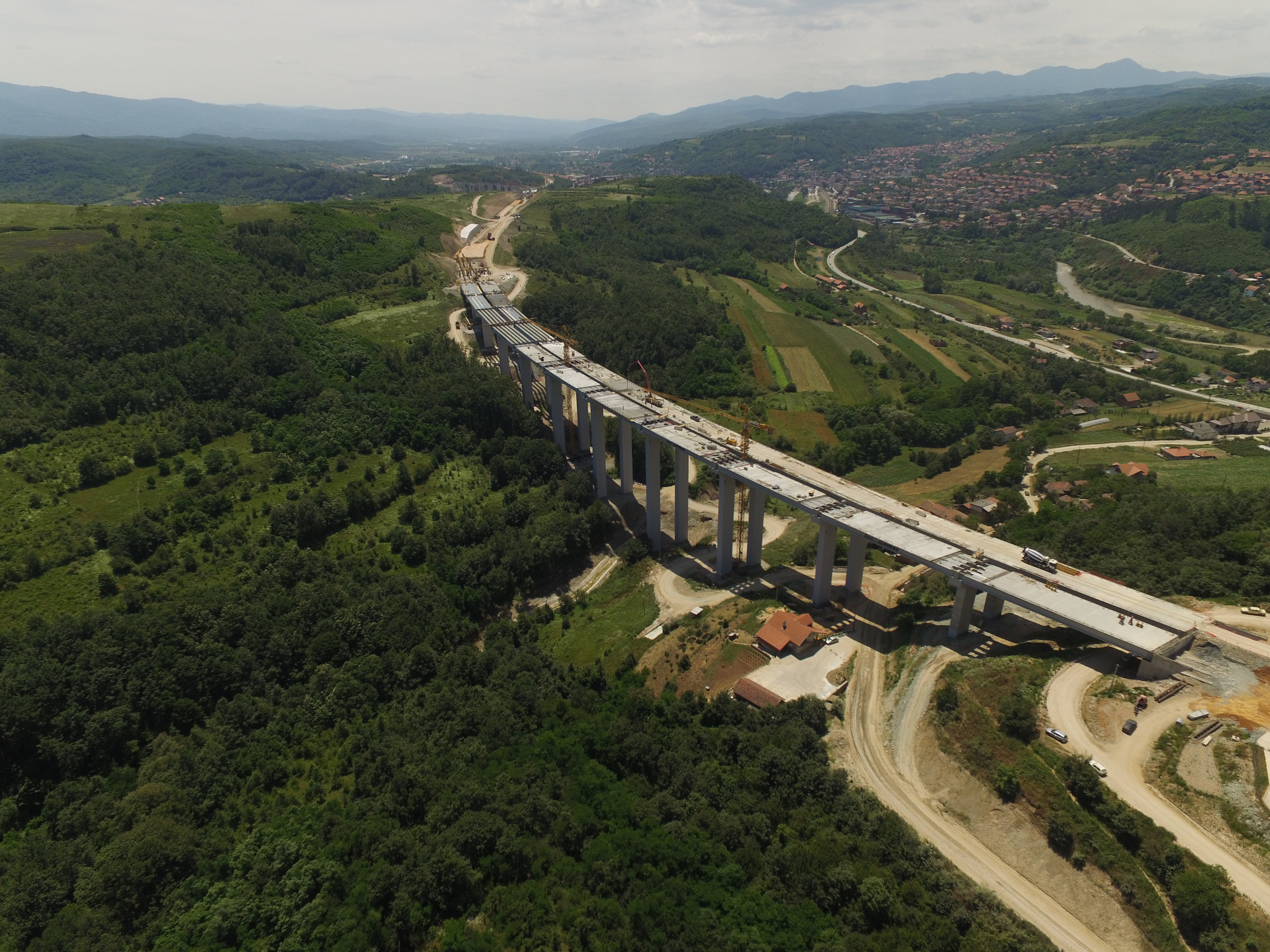
It’s been slow progress on Serbia’s Corridor X project. Gordon Feller reports
Back in the early 2000’s, the
Initially the plan involved two motorways across Greece. The first was a new 780km route including a branch to Ormenio on Greece’s north-east border with Bulgaria. It follows the general route of the Via Egnatia, a Roman road dating from the second century BC. This four-lane motorway will link Igoumenitsa with Kipoi on the Greek–Turkish border.
The second motorway is an upgrade of the 800km Pathe from southern Greece to the north, linking Patras to Promachonas on the Greek–Bulgarian border via Athens and Thessaloniki. The name is derived from the initials of the route: Piraeus – Athens – Thessaloniki; and onto Evzoni, the border crossing with the Republic of Macedonia – the former Yugoslav republic. The four-lane Pathe – six lanes near Athens and Thessaloniki - is the oldest and most important Greek motorway as well as that of the Balkans region. Extensions were agreed in 2004, adding links north from Greece into neighbouring countries and from there into central Europe.
The first branch of these extensions to the Pathe runs from the Greek–Bulgarian border at Promachonas to the Bulgarian capital Sofia along Pan-European Corridor IV, linking Sofia to Thessaloniki.
A second branch of the Pathe leads from the outskirts of Thessaloniki to Evzoni on the Greece–Macedonian border and then north to Macedonia’s capital Skopje. This branch forms the last section of Pan-European Corridor X, connecting Skopje to Thessaloniki.
The cost of the Corridor X program was estimated at €1.3 billion, of which the
Greece was going to provide €100 million for Corridor X. However, the country’s financial crisis forced them to reduce their commitment to only €16 million and ultimately to withdraw any funding for the project.
Serbia took over financing of the remaining work between its southern towns of Donji Neradovac and Levosoje – a move that increased pressure on the Serbian government.
The original loan plan for Corridor X was approved in 2009. A restructuring of the loan in 2014 allowed the use of potential savings to finance construction of a 5.8km extension of the E-75 motorway between the Serbian towns of Caricina Dolina and Vladicin Han. The project’s closing date was then pushed back 12 months to December 31, 2016. The new closing date is now June 30, 2018.
Additional financing from the World Bank extends the closing date by another 18 months. The bank thinks this will allow the project to achieve its original objectives by closing unanticipated financing gaps, covering cost overruns and allowing enough time for works completion.
A statement from Tony Verheijen, the World Bank's country manager for Serbia since August 2013, was published by the World Bank on June 23, “Serbia is regularly taken for a ride by contractors,” he declares.
“The behaviour of some firms that are awarded contracts on large international tenders is plainly awful. They win contracts by underbidding on price, then recuperate through claims processes, they take eight months to mobilise and whenever challenged by the government or financiers, they mobilise their own governments to put pressure on the Serbian one, so that no action is taken. Only once in the last four years has the DPM for infrastructure succeeded in convincing her government colleagues to support terminating a contract with a dismally performing firm and even that took a major effort.”
An internal World Bank document Implementation Status & Results Report, also dated June 23 of this year, stated the current situation this way: “Four works contracts on E-75 (Grabovnica to Grdelica, Lots 1, 2 and 3) have been completed and 31.6km of the E-75 motorway was opened to traffic. Lot 6 experienced delays at the beginning, but the works are now progressing steadily, with expected completion in fall 2017. Remaining works on the E-80 (Lots 1 and 2) were procured in April 2016, but progress on the site has been very slow and remains challenging.”
According to the same document: “In total, there are two lots [on E-80 axis of Corridor X highway] for road work and one for tunnels. Total length of the road sections is 8.7km, out of which tunnels are 2km long. The tunnels are completed.”
Zorana Mihajlovic, Serbia’s infrastructure minister, announced in May this year that, by the end of 2017, a construction contract for the road connecting Corridors X and XI in Serbia will be signed.
She said that project documentation for construction of one road, sometimes known as the Morava Corridor, will be ready by the end of the year. The 109km road will run between the towns of Preljina, in the city of Cacak, and Pojate, in the district of Rasina, representing a link between Corridors X and XI.
The World Bank's internal report dated June 23 this year said that the "revised closing date" is now June 30, 2018. According to that same document, the "original closing date" had been December 31, 2015.
Corridor X will connect Salzburg in Austria to the Greek port of Thessaloniki, passing through Slovenia, Croatia, Serbia and Macedonia. In Serbia, the project includes the construction of a Belgrade bypass motorway, as well as two separate sections, linking the towns of Nis and Merdare, with connections to Serbia’s border with Bulgaria.
Corridor XI officially links Italy's south-eastern port of Bari by ferry across the Adriatic Sea to Montenegro’s port of Bar and then by road to the Serbian capital Belgrade and on to Romania's capital Bucharest.
Mihajlovic said that the agreed deadlines "had to be respected”. She insisted that construction companies which failed to meet contractual obligations would be terminated and be barred from tendering for more work.
Within the Corridor X framework, the Chinese have won contracts to complete two sections: Pojate-Preljina (Morava Corridor) and Novi Sad–Ruma. The total estimated value of the combined contracts is set at €642 million. A preliminary contract was signed with the Chinese in 2012. China Road and Bridge Corporation won the competition, and the Export- Import Bank of China agreed to finance the project.
It is notable that the Chinese are leading Serbian efforts toward the completion of Corridor XI - also known as E-763 and the Belgrade-South Adriatic Highway. The Corridor XI work now underway is focused on the sections linking Obrenovac-Ub and Lajkovac-Ljig, having a combined length of 50km. The total estimated value of the contract is set at €301 million. On the Chinese side the contractor is Shandong Hi-Speed Group. The
Serbia's government plans to start operating these two motorway sections by the end of 2017. The government plans to put into operation stretches on Corridors X and XI with a total length of 80km this year. However, Mihajlovic said the government will be unable to put into operation all road sections of Corridor X in Serbia in 2017 and is ready to terminate contracts awarded to some companies by the end of the construction season due to delays in construction works.
The most serious problems are faced by
In late 2014 the government approved a merger between the public-owned roads companies Putevi Srbije (Roads of Serbia) and Koridori Srbije (Corridors of Serbia). Putevi Srbije maintains roads while Koridori focuses on construction planning and project management, including expropriation of land. At the time of the merger, the government said the deal would contribute to faster completion of projects such as stretches of Corridor X and Corridor XI and hopefully reduce construction costs by around 20%.
This past April, Mihajlovic said the government planned to discuss the inclusion of more companies in the construction of Corridor X, as Aktor does not have enough workers to complete the project by the end of 2017 as planned.





